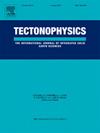An improved assessment of the geodetic/seismic deformation in the Southeastern Tibetan Plateau and its implications for regional seismic hazard
IF 2.7
3区 地球科学
Q2 GEOCHEMISTRY & GEOPHYSICS
引用次数: 0
Abstract
To better understand the moment deficit and seismic coupling in the Southeastern Tibetan Plateau, we jointly analyzed the seismic catalogs and GNSS observations to improve the assessment of earthquake hazards in the area. This study involved an updated GNSS velocity field in a unified reference frame which is used to determine the strain field, and compiled several earthquake catalogs to estimate the Gutenberg-Richer parameter a-value and b-value, as well as the maximum earthquake magnitude in each seismic zone; in addition, the seismogenic thickness in the study region is also estimated. Through these products, we obtained the geodetic moment accumulation rate, seismic moment release rate, and the ratio between them. Our results show that the northern region - including the central-northern segment of the Xianshuihe fault, the Longmen Shan fault, and adjacent areas, and the southern region – including the Menglian fault, Nantinghe fault, and Lancangjiang fault, as well as neighboring regions, have higher seismic coupling indices (>0.8), indicating that these areas may represent fully coupled seismic source zones, the future earthquake hazard in these areas may be lower compared to areas with low seismic coupling. In contrast, in the southern portion of the Xianshuihe fault, the Anninhe-Zemuhe fault, the Daliangshan fault, the southern part of the Jinshajiang fault, as well as the middle-northern part of the Red River fault and nearby regions, the seismic coupling is notably low (<0.3), indicating significant seismic moment deficit and possibly considerable stress accumulation or long-term aseismic deformation in these areas. These areas have a moment deficit of 6.7–7.0 magnitude earthquakes or accumulating seismic moment energy equal to 0.4–1.0 missing earthquakes (M = 7). In addition, the XJF zone has deficit magnitudes ranging from 6.8 to 7.0 or 0.5–1.0 missing earthquakes (M = 7) during the longer catalog period. We classify these areas using a “red-yellow-gray” label system, designating areas with strong earthquake potential and high urgency as red, where future earthquake hazards should be noted. These findings are consistent with the earthquake hazard model, providing valuable insight into potential seismic activity. Taking into account the moment deficit and missing earthquakes estimated by the combination of the geodetic and seismology data, our approach can be applied to the seismic hazard assessment in the Tibetan Plateau or mainland China.
青藏高原东南部大地/地震形变的改进评价及其对区域地震危险性的影响
为了更好地理解青藏高原东南部地震的矩差和地震耦合,我们将地震目录和GNSS观测数据进行了联合分析,以改进该地区的地震危险性评估。本研究利用统一参考系下更新的GNSS速度场来确定应变场,并编制了多个地震目录,估算了各地震带的Gutenberg-Richer参数a值和b值以及最大地震震级;此外,还估算了研究区的发震厚度。通过这些产品,我们得到了大地力矩积累率、地震力矩释放率以及它们之间的比值。结果表明,北部地区(包括鲜水河断裂中北段、龙门山断裂及其邻区)和南部地区(包括孟连断裂、南廷河断裂、澜沧江断裂及其邻区)地震耦合指数较高(>0.8),表明这些地区可能是完全耦合的震源带;与地震耦合较低的地区相比,这些地区未来的地震危险性可能较低。鲜水河断裂带南段、安宁河-则木河断裂带、大梁山断裂带、金沙江断裂带南段、红河断裂带中北部及附近地区地震耦合度明显偏低(<0.3),说明这些地区存在明显的地震矩亏,可能存在较大的应力积累或长期地震变形。这些地区的地震矩亏值为6.7 ~ 7.0级,或累积地震矩能量为0.4 ~ 1.0级的缺震(M = 7)。此外,在较长的目录期内,XJF带的缺震震级为6.8 ~ 7.0级或0.5 ~ 1.0级的缺震(M = 7)。我们使用“红黄灰”标签系统对这些地区进行分类,将具有强烈地震潜力和高度紧急性的地区指定为红色,应注意未来的地震危险。这些发现与地震危险模型一致,为潜在的地震活动提供了有价值的见解。该方法考虑了大地测量和地震学数据结合估算的矩差和缺失地震,可用于青藏高原或中国大陆地区的地震危险性评估。
本文章由计算机程序翻译,如有差异,请以英文原文为准。
求助全文
约1分钟内获得全文
求助全文
来源期刊

Tectonophysics
地学-地球化学与地球物理
CiteScore
4.90
自引率
6.90%
发文量
300
审稿时长
6 months
期刊介绍:
The prime focus of Tectonophysics will be high-impact original research and reviews in the fields of kinematics, structure, composition, and dynamics of the solid arth at all scales. Tectonophysics particularly encourages submission of papers based on the integration of a multitude of geophysical, geological, geochemical, geodynamic, and geotectonic methods
 求助内容:
求助内容: 应助结果提醒方式:
应助结果提醒方式:


